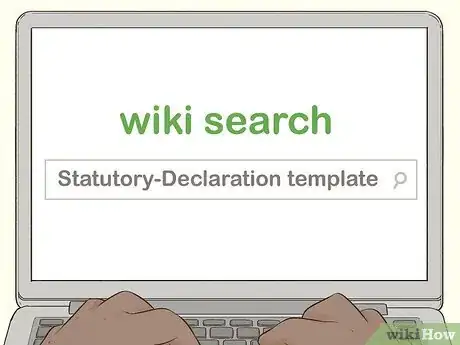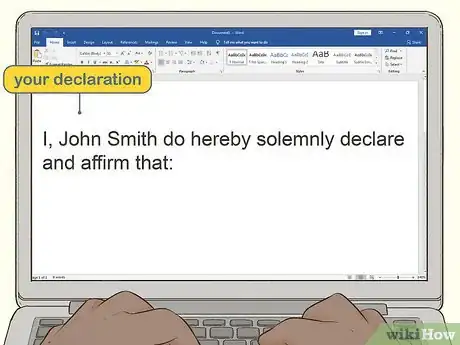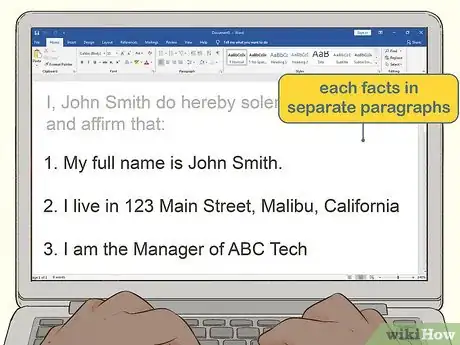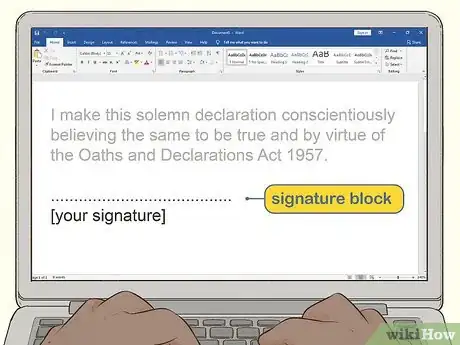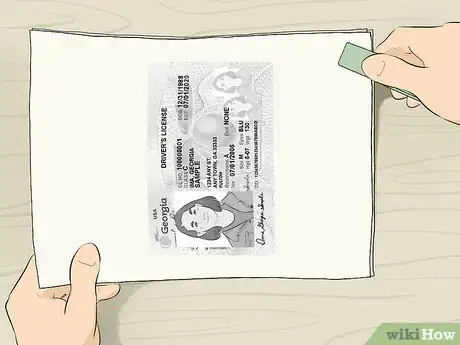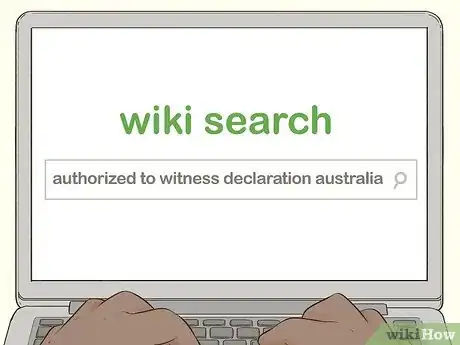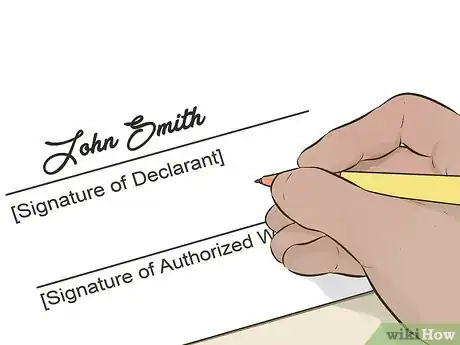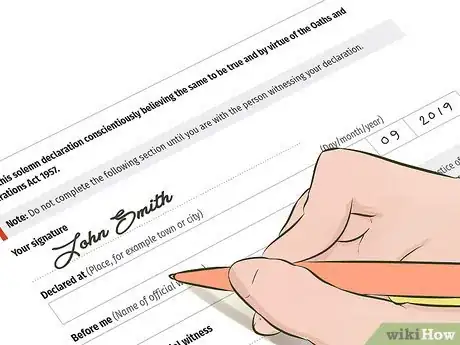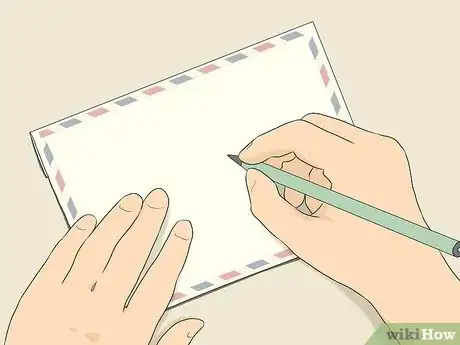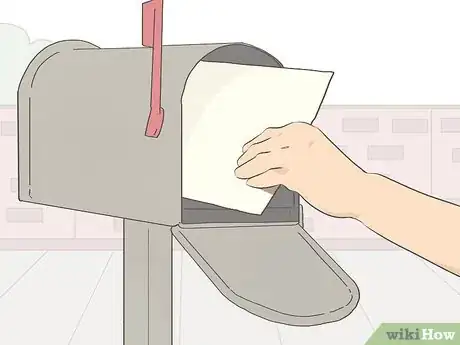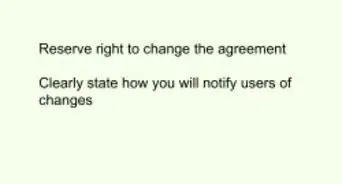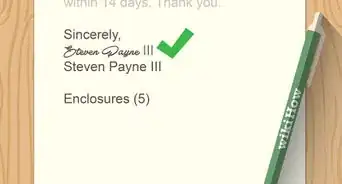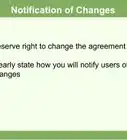This article was co-authored by wikiHow staff writer, Jennifer Mueller, JD. Jennifer Mueller is an in-house legal expert at wikiHow. Jennifer reviews, fact-checks, and evaluates wikiHow's legal content to ensure thoroughness and accuracy. She received her JD from Indiana University Maurer School of Law in 2006.
There are 7 references cited in this article, which can be found at the bottom of the page.
This article has been viewed 35,363 times.
Learn more...
A statutory declaration is a sworn, written statement used to prove a fact that you have knowledge of where there are no formal legal proceedings, such as a trial, where you could testify under oath. These declarations are used primarily in the UK and in British Commonwealth countries, such as Australia and New Zealand. Once you write your statutory declaration, you must sign it in front of an authorized witness. After your declaration is signed and witnessed, you may submit it to the organization that has requested it.[1]
Steps
Drafting Your Declaration
-
1Search for forms or templates. Most government departments and agencies have forms you can use for your statutory declaration. Visit the website of the department or agency that requested the declaration to see if a form is available.[2]
- The website of your country's attorney general may also have generic forms that you can use if no specific form is available. However, most agencies have specific forms that are preferred.
- If you received a written notice requesting a statutory declaration, a form may have been included with that notice.
-
2List your full name, address, and occupation. If no forms were available, start your statement by listing your full legal name. On the following lines, provide the address where you live. Then on the next line, state what you do for a living.[3]
- If you were able to find a form, there typically will be blanks for you to enter this information.
- Make sure you enter the same information that is on your government identification. Include other information if there is a blank for it on the form.
Advertisement -
3Open with a statement that you "do solemnly and sincerely declare." This statement opens a statutory declaration. Make this statement in the first person, using the pronoun "I." Place a colon at the end of this sentence followed by a double-space to begin your statement.[4]
- Your declaration is a sworn statement that may be admissible in court, depending on the circumstances under which you're writing it.
- It is illegal to lie in a statutory declaration in all countries. The penalty varies but may include fines or prison time.
-
4State each of the facts you're declaring in separate paragraphs. Most statutory declarations are written in numbered paragraphs. Only include a single fact in each numbered paragraph. Write all statements in first-person format.[5]
- For example, the fact that you were asked to send something to someone else would be one fact. Your response would be a second fact in a second paragraph.
- Only write statements that you personally know to be true, not something you heard from someone else.
- Stick to the facts that are relevant to the reason you're writing the affidavit.
'Tip: Include a page number on every page, including the first page. Format the page number so that it reads "x of x," where the first "x" is the number of the page and the second "x" is the number of pages in the entire document.
-
5Create a signature block at the end of your declaration. Once you've finished your declaration, you'll need space for both you and the person who witnesses your signature to sign and date the document. Leave at least 4 lines for each signature, as well as a space for the date.[6]
- Your signature blocks shouldn't be a separate page. If you're drafting your own document from scratch, insert a page break, if necessary, to ensure that at least one or two lines of your declaration continue over to the page with the signature blocks.
-
6Include any documents mentioned in your declaration. If you have any documents that back up the assertions you made in your declaration, you should include them along with your declaration. Additionally, you should include any documents that you mentioned in your declaration.[7]
- For example, if one of the facts in your declaration is that you received a notice dated September 1, 2019, you should include a copy of that notice along with your declaration.
Signing Your Declaration
-
1Find out who's authorized to witness your declaration in your country. Different countries allow different professionals to witness statutory declarations. Typically, a justice of the peace, solicitor, or notary public is authorized. In some countries, additional professionals may be authorized.[8]
- For example, in Australia, you may also have your statutory declaration witnessed by a police officer, bank manager, medical practitioner, or dentist.[9]
- A full list will typically be available on the website of the organization or government agency that requested the statutory declaration. You may have to do some searching locally beyond that to find someone who is authorized to witness your declaration.
- Keep in mind that you'll typically have to pay a fee to the professional who witnesses your statutory declaration. This fee may be governed by statute, but will likely vary among professionals.
Tip: Call ahead once you've found someone who is authorized to witness your declaration, rather than just showing up at their office. Some professionals may be unwilling to witness statutory declarations and others may require you to make an appointment.
-
2Sign each page of your declaration. In the presence of your witness, sign each page of your declaration in blue or black ink. In most countries, your witness must also sign each page. This verifies that you've sworn to each page and that the declaration is complete.[10]
- Signing each page prevents pages from later being added that include facts you didn't state or agree to.
- If you've attached documents to your declaration, you may also have to sign a certificate identifying that document as an "exhibit" to your declaration.
-
3Make your oath in front of your witness. Typically, you also must make a verbal statement swearing that the facts you wrote in your declaration are true and correct to the best of your knowledge. The specific wording may vary. Your witness will have a copy of the wording required.[11]
- For example, in Australia, you must say "I," followed by your full name and address, "declare that the contents of this declaration are true and correct."
- The certificate also identifies the document as an exhibit to the declaration
-
4Sign and date the last page of your declaration. Once you've made your oral oath, you'll sign and date in the signature block at the end of your declaration. Your witness will also sign and date the declaration as your witness.[12]
- Your witness will need to write their professional information and qualification to witness a statutory declaration. They may have a seal they also have to affix.
Submitting Your Statutory Declaration
-
1Make a copy of your signed and witnessed declaration for your records. Before you send your declaration to the organization that requested it, you need a copy of the signed declaration and any accompanying documents for your records. Keep it in a safe place where you normally store other legal documents.[13]
-
2Determine where you need to send your statutory declaration. If you have a written notice requesting the statutory declaration, it may provide instructions on how to submit your declaration. Otherwise, the website of the organization that requested the declaration may have more information.[14]
- Make sure you send you're sending your declaration to the right place. Some government departments or agencies may want you to submit your declaration to another department or agency for processing.
-
3Scan your entire declaration to submit it electronically. Many government agencies allow you to scan your signed declaration and any exhibits and send it electronically. This may involve either sending it through the agency's website or emailing to a specific email address.[15]
- If you received a notice requesting the declaration, you may find instructions there. You can also check the agency directly.
Tip: If you send a scanned document to the organization that requested it, make sure you keep the originals in your records in case they are requested.
-
4Mail your statutory notice to the appropriate address. Some agencies don't accept electronic submission of statutory declarations. If the agency wants the actual document, you'll typically be told where to mail it once it's complete. If you're not sure, contact the agency directly and ask for the address to mail a statutory declaration.[16]
- If you have the option, mail it using a method that provides tracking and confirmation of receipt, so you'll know when the agency received it. Keep your confirmation and receipt for your records.
References
- ↑ https://www.lawaccess.nsw.gov.au/Pages/representing/lawassist_readingwritinghome_wysk/lawassist_affidavits_wysk/lawassist_stat_decs_wysk.aspx
- ↑ https://www.govt.nz/browse/law-crime-and-justice/making-a-statutory-declaration/
- ↑ https://www.lawaccess.nsw.gov.au/Pages/representing/lawassist_readingwritinghome_wysk/lawassist_affidavits_wysk/lawassist_stat_decs_wysk.aspx
- ↑ https://www.lawaccess.nsw.gov.au/Pages/representing/lawassist_readingwritinghome_wysk/lawassist_affidavits_wysk/lawassist_stat_decs_wysk.aspx
- ↑ https://www.lawaccess.nsw.gov.au/Pages/representing/lawassist_readingwritinghome_wysk/lawassist_affidavits_wysk/lawassist_stat_decs_wysk.aspx
- ↑ https://www.justice.vic.gov.au/statdecs
- ↑ https://www.lawaccess.nsw.gov.au/Pages/representing/lawassist_readingwritinghome_wysk/lawassist_stat_dec_checklist.aspx
- ↑ https://www.govt.nz/browse/law-crime-and-justice/making-a-statutory-declaration/
- ↑ https://www.justice.vic.gov.au/statdecs
- ↑ https://www.justice.vic.gov.au/statdecs
- ↑ https://www.justice.vic.gov.au/statdecs
- ↑ https://www.justice.vic.gov.au/statdecs
- ↑ https://www.lawaccess.nsw.gov.au/Pages/representing/lawassist_readingwritinghome_wysk/lawassist_stat_dec_checklist.aspx
- ↑ https://tfl.gov.uk/modes/driving/congestion-charge/penalties-and-enforcement/challenge-a-penalty-charge/make-a-statutory-declaration
- ↑ https://iihelp.iinet.net.au/How_to_Lodge_a_Statutory_Declaration_Form
- ↑ https://www.service.nsw.gov.au/transaction/submit-statutory-declaration-toll-notice
